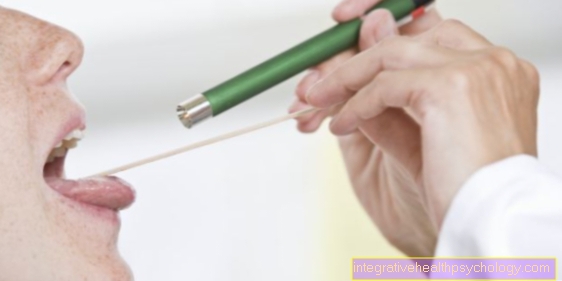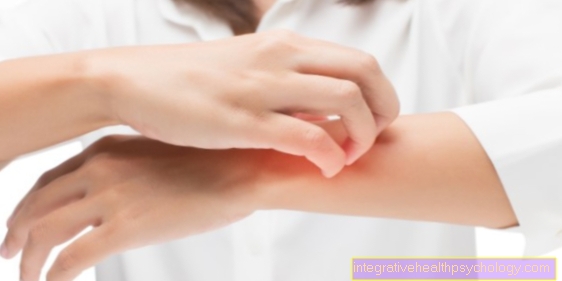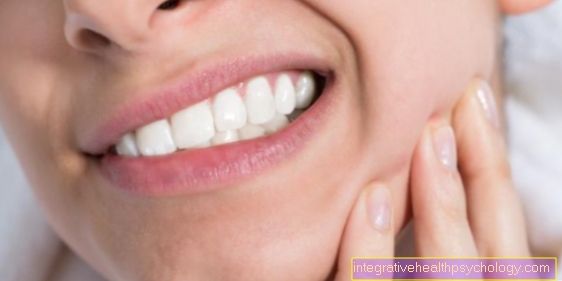Dander
definition
Skin flakes are small parts of the skin that peel off from its surface.
Dandruff (dermatological term: Squama) come about because cells of the top layer of the skin, the horny cells (Keratinocytes) the horny layer (Stratum corneum), die and as a result separate from the other skin layers. This is a completely normal process as our skin is constantly renewing itself; the old cells make room, so to speak, for the new ones coming from below.
However, the “flakes” of skin that arise as part of this natural regeneration process are usually so small that you don't even notice them. The skin flakes only become visible to the human eye when around 500 cells have accumulated.
test

Classification
The dander can be based on different characteristics subdivide:
- Classification according to size the dander:
fine, medium or coarse lamellar - Classification according to shape the dander:
leaf-, plate-, platelet- or bran-shaped
The size and shape of the horn scales can often be enough Clue for the cause the shed deliver.
What are the causes of dander?
Dander can have different causes. The most common cause is dry skin. The dryness and reduced work of the sebum glands lead to an imbalance in the skin. Dandruff formation occurs as a result of increased dying and new skin regrowth. Dandruff is flaked off skin. Fatty ointments such as linola grease or bepanthen ointment help against dry skin. Mixed creams from the dermatologist can also be very helpful, as these creams are individually tailored to the texture of the skin.
Another reason for flaky skin can be skin fungus (Mycosis). In principle, the fungus can occur anywhere, but mostly manifests itself in warm, moist areas of the skin. These include the genital area, skin folds and the armpit. Here the therapy of choice is a fungicidal agent (Antifungal agent). Canesten® is freely available, but a doctor should be consulted in the event of severe fungal attack.
Dandruff can also be caused by psoriasis (psoriasis). This is an inflammatory disease. Psoriasis is associated with reddening and flaking of the skin, and occasionally with itching and pain. Psoriasis requires systemic therapy, in the acute episode with cortisone. Inpatient admission is often unavoidable.
Read more on the topic: Cause of dandruff
Dander - what disease is behind it?
Dander can have a variety of causes. The most common cause is dry skin. The dry skin is triggered by insufficient function of the sebum glands. Therefore, there is increased death of the skin with exfoliation of the skin particles. Another common cause of dandruff is fungus on the skin. The skin fungus can occur anywhere on the body, but is mostly localized in the mouth, on the genitals or in skin folds. In the worst case, psoriasis, a skin disease with antibody formation, can cause flaky skin. Psoriasis is associated with other physical symptoms and must be treated systemically.
Dander from make-up
Make-up should be chosen carefully. Attention should be paid to the condition of the skin and the individual tolerance. It is advisable to try out several products and, in the event of particular problems, to seek advice from your dermatologist. The biggest problem with makeup related to dandruff is that some makeup is particularly dehydrating. It can help if an opaque day cream is used instead of make-up. Although this does not have as much coverage as the make-up, it gives the skin more moisture and does not clog the pores. This also results in fewer pimples.
Read more on the topic: Dry skin - causes and care tips
In general, it is important to remove make-up well at night. This should be done with a cleansing milk or cleansing oil. Here, too, it is important to ensure compatibility. Heavy rubbing should be avoided. If possible, it is advisable to leave the make-up off for a few days if the skin is flaky so that the skin can recover. Here it is good to let air into the skin.
UV radiation (Sun) can have a healing effect on the skin to a limited extent. Of course, you have to pay attention to the dose. In the event of prolonged exposure to the sun, it is essential to ensure a sun protection factor. Continuous exposure to the sun can cause the skin to age prematurely, and there is also a risk of white skin cancer (Basalioma) and black skin cancer (Melanoma) elevated. Both clinical pictures have to be removed surgically and require increased control by the dermatologist.
Harmless temporary skin flaking
Most of the skin flakes are harmless and only present temporarily.
- In Germany, almost every second person will suffer from it at some point in their life Dandruff.
- Even simple inflammations or injuries to the skin can sometimes be accompanied by flaking if the skin has to renew a larger area at once. A classic example of this is the sunburn.
Skin disorders
A sign that dandruff is on your skin at one real illness Suggest are, among other things, if the skin in addition to flaking Signs of inflammation (Redness, swelling, warmth or pain) the affected areas itch or yourself there Form crusts.
In such cases one should if possible doctor to clarify the cause of the dandruff.
- psoriasis
Psoriasis is one benign Skin disease. In this condition, dandruff is most commonly found over the Joints of the extensor sides, especially on Elbow.
The skin flakes are usually here silvery white, raised above the skin level and have a sharp boundary. The surrounding skin is mostly red and itchy. The extent of the symptoms, however, varies greatly from case to case, so that some hardly notice the disease, while others are severely impaired in their quality of life due to the very noticeable skin changes. - Seborrheic eczema
is a skin condition caused by the Overproduction of sebum is marked. As a result, those areas of the skin in which there are a particularly large number of sebum glands are particularly affected, such as on the Scalp. In contrast to psoriasis and neurodermatitis, the skin flakes that develop here are more likely to be in the vicinity greasy as dry. - Fungal attack
A fungal attack can also occur Dander to lead. In healthy people, the immune system can usually keep fungus colonization in check, but it should weakened immune system are present, are additionally stressed by an underlying disease or by additional stressful circumstances such as intense sunlight, the fungi can spread on the skin. - Neurodermatitis
this is a inflammatory-allergic disease, which is often associated with flaking and usually already in Childhood begins. In many cases, those affected also suffer from other allergic reactions, such as itchy, watery eyes, runny nose, or asthma. Neurodermatitis almost always runs in burstswhich means that the discomfort is not permanent. In a surge, however, the flakes of skin are typically located over the Flexors, for example in the Elbow. - Ichthyosis vulgaris (Fish scale disease)
Fish scale disease is one hereditary Skin disease with massive formation of dander. The name comes from the fact that the skin is often used here large area (mostly on the extensor sides of joints) with small grayish to greenish scales lying close together so that its surface resembles the skin of a fish or reptile. - Rare causes
syphilis, measles, Scarlet fever and various contact allergies.
Psoriasis
Skin psoriasis, also known as psoriasis, is an inflammatory skin disease. It usually occurs after puberty and can only be treated systemically. In addition to skin symptoms, psoriasis can also be associated with joint problems and vascular inflammation. Various options are available for treating psoriasis. These are used depending on the severity of the symptoms.
Read more on the topic: Psoriasis
Localization of skin flakes
Dander can appear on different parts of the body. The affected areas are not only the face or scalp, but also the genital area or extremities. The following sections provide an overview of the affected parts of the body.
Flakes of skin on the face
The skin of the face is very sensitive. Therefore, only creams specially made for the facial skin should be used on the face. The skin of the face is unprotected and is therefore in direct contact with the environment. Dander on the face mostly occurs when the skin on the face is extremely dry. Since the face is always visible, they represent a particular burden for those affected. A dermatologist should be consulted if the main problems affect the face. Here creams can be mixed together individually for each skin type so that the cream optimally meets the needs of the skin. In the case of flaky skin, the right skin care product should be selected depending on the cause. If the cream is too greasy, it can promote pimple formation, especially on the skin of the face. If the skin is too dry, this can lead to increased flaking.
Read more on the topic: Dry skin on the face
Flaky scalp
The scalp is the most common place for flaky skin. This is due to the fact that a lot of water acts on the scalp from frequent hair washing, which can lead to dryness. Shampoos and conditioners can also irritate the scalp. Here it is advisable to switch to a scalp-friendly shampoo. We recommend Linola shampoo or the well-known anti-dandruff shampoo "Head and Shoulders". These shampoos moisturize the scalp in a mild way and help the skin to regenerate. In addition, the greasiness of the hair can usually be reduced in this way.
Read more on the topic: Dry scalp - what to do?
In the ear
The flakes of skin in the ear result from an imbalance in the skin. Like the skin of the face, the skin in the ear can begin to flake if the skin becomes too dry. Here, too, it is advisable to use creams prescribed by the dermatologist. The special feature of the ear is that, in contrast to the rest of the skin, it is a warmer and more humid place. This favors the nesting of mushrooms. If the skin becomes infected with fungus, it can lead to reddening and itching as well as flaking. The fungus can lodge anywhere on the skin, and antifungal therapy should be initiated in the event of a fungal attack to stop the fungal attack on the skin and prevent it from spreading further.
On the nose
Flaky skin appears on the nose for the same reason as the rest of the face. Dry skin leads to increased flaking. There is nothing else to look for on the nose than on the face. Here, too, the therapy of choice is a moisturizing cream. It should be noted that the anatomical position of the nose can lead to increased solar radiation. It is therefore recommended to use a sun protection factor even when there is little sunlight. Excessive sun exposure can also lead to flaking of the skin in the form of sunburn.
On the eyebrows
The skin on the eyebrows is also facial skin. Plucking the eyebrows can cause additional skin irritation. Since it is hairy skin, it can lead to increased oily from sebum glands. If these lose their function due to the cold and the subsequent reduced blood supply to the skin, flaking can occur.
On the scrotum
The scrotum is surrounded by a moist and warm environment. Especially in the intimate area, which is often predestined for a fungal attack due to a lot of clothing, a fungus must be considered if there is flaking on this area of the skin. If the flaking is associated with itching and reddening, a fungal attack is very likely. Here a doctor should be consulted and antifungal treatment (Treatment against fungal attack) with an ointment (for example Canesten) (see also: Medicines against fungal infections). It should also be noted that the fungus can be transmitted during sexual intercourse, which can lead to a fungal infection of the vagina in women.
On the hands
On the hands in particular, flaking of the skin can also be attributed to contact dermatitis. Contact dermatitis is an inflammatory reaction of the skin to chemicals. These can be soap, creams and much more. Since the hands come into contact with many substances, these areas of the skin are predestined for this. Contact dermatitis or contact eczema often occurs in the context of occupational diseases. These are often gloves used by medical personnel, disinfectants or components used in the processing of leather (see also: Hand eczema). Here the substance must be removed in order to avoid further existence of the contact eczema.
Read more on this topic at: Contact dermatitis
On the legs
The legs, especially the shins, are also a typical location for flaky skin. This area of skin is often very dry. In addition, this area of skin can be irritated from frequent shaving. A nourishing body lotion usually helps here. If a body lotion does not help, a dermatologist should be consulted to further clarify the skin change.
The whole body
The flaking of the skin all over the body is unlikely. If it does occur, a skin disease should be considered. Scaling often occurs on different parts of the body in psoriasis, but neurodermatitis can also cause such symptoms. Psoriasis is an inflammatory disease that can involve the joints. Neurodermatitis is also an inflammatory skin disease. Neurodermatitis usually begins in childhood and is not infrequently self-limiting in puberty. The neurodermatitis can be accompanied by a very strong itching.
therapy
In the simplest case, skin flakes simply come about because the skin is too dry. Then you can do self-treatment. This therapy is mainly based on supplying the skin with sufficient fluid. Various care products and cleaning agents are available for this. Urea (this not only moisturizes the skin, but can also loosen dandruff) and oil-based preparations (for example almond oil, soybean oil or peanut oil) are particularly suitable. Regular moisturizing baths also help to supply the skin with moisture. In addition, you should make sure that you only use cosmetics articles designated for dry skin, that you do not wash your skin too often or stay in the water for too long and drink enough fluids.
If the flakes of skin are the symptom of an underlying disease, it is important that this disease is treated appropriately, otherwise the flakes of skin cannot recede (at least not permanently). Dandruff from psoriasis can be removed using ointment dressings that contain active ingredients such as urea, lactic acid or salicylic acid. In addition, it is important to also use anti-inflammatory drugs such as cortisone (caution: do not use too long, otherwise the affected skin will become thinner and thinner), dithranol or calcitriol (derived from vitamin D). If symptoms are more severe, local therapy can be switched to systemic treatment. Then, for example, retinoids (derived from vitamin A) can be taken to loosen the dandruff more quickly and to inhibit cell growth. Substances that suppress the immune system, such as methotrexate, can also be used. Alternatives are treatment with UV radiation or laser, which, however, may only be carried out under strict medical supervision.
If the flakes of skin developed on the base of neurodermatitis, anti-inflammatory drugs such as cortisone and immunosuppressants such as tacrolimus also help. Light and climatic therapy are also already established for atopic dermatitis. Other drugs that are used in atopic dermatitis target the allergic component of this disease. Antihistamines or specific immunotherapy (hyposensitization) help against dander in neurodermatitis.
In the case of flakes of skin caused by fungal infections, special antifungal agents (antimycotics) should be applied to the affected areas. These are available, mostly without a prescription, in various dosage forms: as powders, creams, solutions, sprays and, for therapy-resistant processes, also as tablets. Bifonazole, clotrimazole or terbinafine are particularly popular for the skin. It is important that the treatment is carried out consistently for three to four weeks (see package insert), even if the dandruff disappears earlier.
Of course, the general measures described above can also help against dander caused by these diseases.
Read more on the topic: How To Treat Dandruff The Right Way!
How can I remove flakes of skin?
Dander is difficult to remove from the skin. It is therefore important to find the cause of the dandruff and treat it. The simplest and most common explanation is dry skin. This usually occurs in the winter months due to the cold or frequent contact with water. The hands and scalp are mainly affected here. The therapy for dry skin is a nourishing skin cream. This can be as rich as Linola Fett or Bepanthen®.
If the skin is oily despite the flaking, it is worth going to the dermatologist. The dermatologist can have creams mixed individually for each skin type in the pharmacy. If there is another reason for the flaking of the skin, a doctor must also be consulted. If it is a skin fungus, it should be treated with an antimycotic to prevent the fungus from spreading. If the disease is autoimmune, systemic treatment should be sought. This may have to be done as an inpatient over several days or weeks.
Read more on the topic: This is how dry skin is treated!
Home remedies for dander
There are many home remedies for dander. A well-known remedy for flaky scalp is hair tonic. It can be composed in different ways, often including nettles. The hair lotion can be prepared according to a recipe. Another tip against dandruff is tea tree oil. It is available in drugstores and is effective against many major problems. In addition to reducing dandruff, tea tree oil is also said to have an antifungal effect. The tea tree oil can also be used on pimples and blackheads and is therefore very versatile. Olive oil or coconut oil can also be used all over the skin to combat dry skin. The oil provides moisture and is said to bring the skin back into balance. The olive oil or coconut oil can also be used on the scalp.
Can fish dander be permanently removed?
The therapy with fish against calluses and dandruff is becoming more and more popular. These are fish in a pool of water that nibble off calluses and scales from their feet or hands. They feed on flakes of skin. The fish are also effective against psoriasis (psoriasis) to temporarily relieve the symptom of flaky skin. However, due to the formation of new skin, flakes of skin keep returning without treating the cause. The fish are only used to briefly remove the scales until they can be reproduced again. It is the same with the cornea. Therapy with fish is very expensive.





























